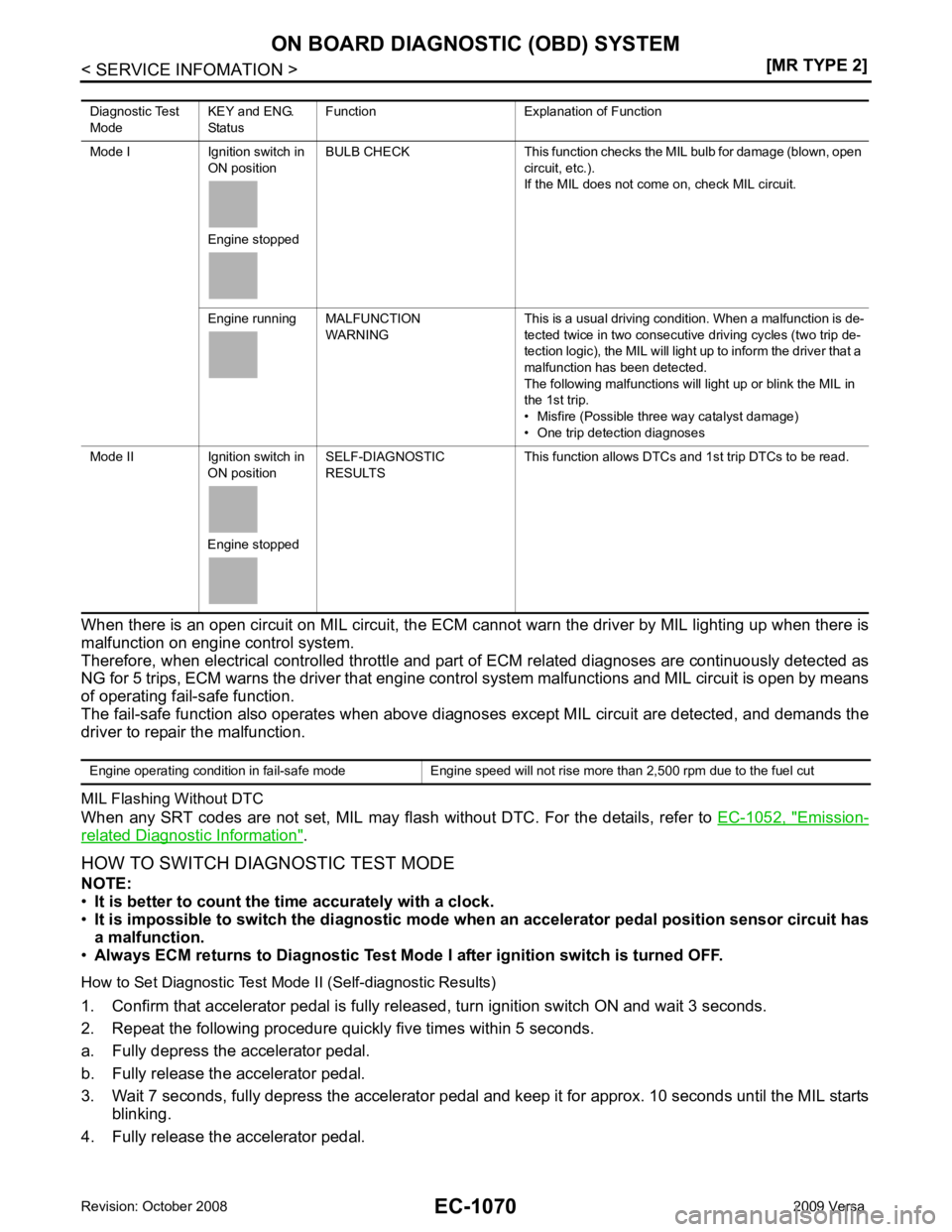NISSAN LATIO 2009 Service Repair Manual
Manufacturer: NISSAN, Model Year: 2009, Model line: LATIO, Model: NISSAN LATIO 2009Pages: 4331, PDF Size: 58.04 MB
Page 2421 of 4331

EC
NP
O
EGR
SYSTEM 31H EGR function P0400 80H 96H
Low Flow Faults: EGR temp change
rate (short term)
P0400 81H 96H Low Flow Faults: EGR temp change
rate (long term)
P0400 82H 96H Low Flow Faults: Difference between
max EGR temp and EGR temp under
idling condition
P0400 83H 96H Low Flow Faults: Max EGR temp
P1402 84H 96H High Flow Faults: EGR temp increase
rate
VVT
SYSTEM 35H VVT Monitor (Bank1)
P0011 80H 9DH
VTC intake function diagnosis (VTC
alignment check diagnosis)
P0014 81H 9DH VTC exhaust function diagnosis (VTC
alignment check diagnosis)
P0011 82H 9DH VTC intake function diagnosis (VTC
drive failure diagnosis)
P0014 83H 9DH VTC exhaust function diagnosis (VTC
drive failure diagnosis)
36H VVT Monitor (Bank2) P0021 80H 9DH
VTC intake function diagnosis (VTC
alignment check diagnosis)
P0024 81H 9DH VTC exhaust function diagnosis (VTC
alignment check diagnosis)
P0021 82H 9DH VTC intake function diagnosis (VTC
drive failure diagnosis)
P0024 83H 9DH VTC exhaust function diagnosis (VTC
drive failure diagnosis)
EVAP
SYSTEM 39H
EVAP control system leak
(Cap Off) P0455 80H 0CH
Difference in pressure sensor output
voltage before and after pull down
3BH EVAP control system leak
(Small leak) P0442 80H 05H
Leak area index (for more than 0.04
inch)
3CH EVAP control system leak
(Very small leak) P0456 80H 05H
Leak area index (for more than 0.02
inch)
P0456 81H FDH Maximum internal pressure of EVAP
system during monitoring
3DH Purge flow system P0441 83H 0CH Difference in pressure sensor output
voltage before and after vent control
valve close
O2 SEN-
SOR
HEATER 41H
A/F sensor 1 heater
(Bank 1) Low Input:P0031
High Input:P0032 81H 0BHConverted value of Heater electric cur-
rent to voltage
42H Heated oxygen sensor 2 heat-
er (Bank 1) Low Input:P0037
High Input:P0038 80H 0CH
Converted value of Heater electric cur-
rent to voltage
43H Heated oxygen sensor 3 heat-
er (Bank 1) P0043 80H 0CHConverted value of Heater electric cur-
rent to voltage
45H A/F sensor 1 heater
(Bank 2) Low Input:P0051
High Input:P0052 81H 0BHConverted value of Heater electric cur-
rent to voltage
46H Heated oxygen sensor 2 heat-
er (Bank 2) Low Input:P0057
High Input:P0058 80H 0CH
Converted value of Heater electric cur-
rent to voltage
47H Heated oxygen sensor 3 heat-
er (Bank 2) P0063 80H 0CHConverted value of Heater electric cur-
rent to voltage
Item
OBD-
MID Self-diagnostic test item DTC Test value and Test
limit
(GST display) Description
TID Unit and
Scaling ID
Page 2422 of 4331

Page 2423 of 4331

EC
NP
O
MISFIRE A1H Multiple Cylinder Misfires P0301 80H 24H
Misfiring counter at 1000 revolution of
the first cylinder
P0302 81H 24H Misfiring counter at 1000 revolution of
the second cylinder
P0303 82H 24H Misfiring counter at 1000 revolution of
the third cylinder
P0304 83H 24H Misfiring counter at 1000 revolution of
the fourth cylinder
P0305 84H 24H Misfiring counter at 1000 revolution of
the fifth cylinder
P0306 85H 24H Misfiring counter at 1000 revolution of
the sixth cylinder
P0307 86H 24H Misfiring counter at 1000 revolution of
the seventh cylinder
P0308 87H 24H Misfiring counter at 1000 revolution of
the eighth cylinder
P0300 88H 24H Misfiring counter at 1000 revolution of
the multiple cylinders
P0301 89H 24H Misfiring counter at 200 revolution of the
first cylinder
P0302 8AH 24H Misfiring counter at 200 revolution of the
second cylinder
P0303 8BH 24H Misfiring counter at 200 revolution of the
third cylinder
P0304 8CH 24H Misfiring counter at 200 revolution of the
fourth cylinder
P0305 8DH 24H Misfiring counter at 200 revolution of the
fifth cylinder
P0306 8EH 24H Misfiring counter at 200 revolution of the
sixth cylinder
P0307 8FH 24H Misfiring counter at 200 revolution of the
seventh cylinder
P0308 90H 24H Misfiring counter at 200 revolution of the
eighth cylinder
P0300 91H 24H Misfiring counter at 1000 revolution of
the single cylinder
P0300 92H 24H Misfiring counter at 200 revolution of the
single cylinder
P0300 93H 24H Misfiring counter at 200 revolution of the
multiple cylinders
Item
OBD-
MID Self-diagnostic test item DTC Test value and Test
limit
(GST display) Description
TID Unit and
Scaling ID
Page 2424 of 4331

), skip step 1.
1. Erase DTC in TCM.
2. Select "ENGINE" with CONSULT-III.
3. Select "SELF-DIAG RESULTS". MISFIRE
A2H No. 1 Cylinder Misfire
P0301 0BH 24H
EWMA (Exponential Weighted Moving
Average) misfire counts for last 10 driv-
ing cycles
P0301 0CH 24H Misfire counts for last/current driving cy-
cles
A3H No. 2 Cylinder Misfire P0302 0BH 24H
EWMA (Exponential Weighted Moving
Average) misfire counts for last 10 driv-
ing cycles
P0302 0CH 24H Misfire counts for last/current driving cy-
cles
A4H No. 3 Cylinder Misfire P0303 0BH 24H
EWMA (Exponential Weighted Moving
Average) misfire counts for last 10 driv-
ing cycles
P0303 0CH 24H Misfire counts for last/current driving cy-
cles
A5H No. 4 Cylinder Misfire P0304 0BH 24H
EWMA (Exponential Weighted Moving
Average) misfire counts for last 10 driv-
ing cycles
P0304 0CH 24H Misfire counts for last/current driving cy-
cles
A6H No. 5 Cylinder Misfire P0305 0BH 24H
EWMA (Exponential Weighted Moving
Average) misfire counts for last 10 driv-
ing cycles
P0305 0CH 24H Misfire counts for last/current driving cy-
cles
A7H No. 6 Cylinder Misfire P0306 0BH 24H
EWMA (Exponential Weighted Moving
Average) misfire counts for last 10 driv-
ing cycles
P0306 0CH 24H Misfire counts for last/current driving cy-
cles
A8H No. 7 Cylinder Misfire P0307 0BH 24H
EWMA (Exponential Weighted Moving
Average) misfire counts for last 10 driv-
ing cycles
P0307 0CH 24H Misfire counts for last/current driving cy-
cles
A9H No. 8 Cylinder Misfire P0308 0BH 24H
EWMA (Exponential Weighted Moving
Average) misfire counts for last 10 driv-
ing cycles
P0308 0CH 24H Misfire counts for last/current driving cy-
cles
Item
OBD-
MID Self-diagnostic test item DTC Test value and Test
limit
(GST display) Description
TID Unit and
Scaling ID
Page 2425 of 4331
![NISSAN LATIO 2009 Service Repair Manual ON BOARD DIAGNOSTIC (OBD) SYSTEM
EC-1069
< SERVICE INFOMATION >
[MR TYPE 2] C
D E
F
G H
I
J
K L
M A EC
NP
O
4. Touch "ERASE". (The DTC in the ECM will be erased.)
With GST
NOTE:
If the ignition switc NISSAN LATIO 2009 Service Repair Manual ON BOARD DIAGNOSTIC (OBD) SYSTEM
EC-1069
< SERVICE INFOMATION >
[MR TYPE 2] C
D E
F
G H
I
J
K L
M A EC
NP
O
4. Touch "ERASE". (The DTC in the ECM will be erased.)
With GST
NOTE:
If the ignition switc](/img/5/57359/w960_57359-2424.png)
ON BOARD DIAGNOSTIC (OBD) SYSTEM
EC-1069
< SERVICE INFOMATION >
[MR TYPE 2] C
D E
F
G H
I
J
K L
M A EC
NP
O
4. Touch "ERASE". (The DTC in the ECM will be erased.)
With GST
NOTE:
If the ignition switch stays ON after repair work, be sure to turn ignition switch OFF once. Wait at least 10 sec-
onds and then turn it ON (engine stopped) again.
1. Select Service $04 with GST.
No Tools
NOTE:
If the ignition switch stays ON after repair work, be sure to turn ignition switch OFF once. Wait at least 10 sec-
onds and then turn it ON (engine stopped) again.
1. Erase DTC in ECM. Refer to How to Erase Diagnostic Test Mode II (Self-diagnostic Results).
• If the battery is disconnected, the emission-relate d diagnostic information will be lost within 24
hours.
• The following data are cleared when the ECM memory is erased.
- Diagnostic trouble codes
- 1st trip diagnostic trouble codes
- Freeze frame data
- 1st trip freeze frame data
- System readiness test (SRT) codes
- Test values
Malfunction Indicator Lamp (MIL) INFOID:0000000004499927
DESCRIPTION The MIL is located on the instrument panel.
1. The MIL will light up when the ignition switch is turned ON with- out the engine running. This is a bulb check.
If the MIL does not light up, refer to DI-20 or see
EC-1532 .
2. When the engine is start ed, the MIL should go off.
If the MIL remains on, the on board diagnostic system has
detected an engine system malfunction.
ON BOARD DIAGNOSTIC SYSTEM FUNCTION The on board diagnostic system has the following three functions. SEF217U
Page 2426 of 4331

Emission-
related Diagnostic Information " .
HOW TO SWITCH DIAGNOSTIC TEST MODE
NOTE:
• It is better to count the ti me accurately with a clock.
• It is impossible to switch the di agnostic mode when an accelerator pedal position sensor circuit has
a malfunction.
• Always ECM returns to Diagnostic Test Mode I after ignition switch is turned OFF.
How to Set Diagnostic Test Mode II (Self-diagnostic Results)
1. Confirm that accelerator pedal is fully releas ed, turn ignition switch ON and wait 3 seconds.
2. Repeat the following procedure quickly five times within 5 seconds.
a. Fully depress the accelerator pedal.
b. Fully release the accelerator pedal.
3. Wait 7 seconds, fully depress the accelerator pedal and keep it for approx. 10 seconds until the MIL starts blinking.
4. Fully release the accelerator pedal. Diagnostic Test
Mode KEY and ENG.
Status Function Explanation of Function
Mode I Ignition switch in ON position
Engine stopped BULB CHECK This function checks the MIL bulb for damage (blown, open
circuit, etc.).
If the MIL does not come on, check MIL circuit.
Engine running MALFUNCTION WARNING This is a usual driving condition. When a malfunction is de-
tected twice in two consecutive driving cycles (two trip de-
tection logic), the MIL will light up to inform the driver that a
malfunction has been detected.
The following malfunctions will light up or blink the MIL in
the 1st trip.
• Misfire (Possible three way catalyst damage)
• One trip detection diagnoses
Mode II Ignition switch in ON position
Engine stopped SELF-DIAGNOSTIC
RESULTS This function allows DTCs an
d 1st trip DTCs to be read.
Page 2427 of 4331
![NISSAN LATIO 2009 Service Repair Manual ON BOARD DIAGNOSTIC (OBD) SYSTEM
EC-1071
< SERVICE INFOMATION >
[MR TYPE 2] C
D E
F
G H
I
J
K L
M A EC
NP
O
ECM has entered to Diagnostic Test Mode II (Self-diagnostic results).
How to Erase Diagnosti NISSAN LATIO 2009 Service Repair Manual ON BOARD DIAGNOSTIC (OBD) SYSTEM
EC-1071
< SERVICE INFOMATION >
[MR TYPE 2] C
D E
F
G H
I
J
K L
M A EC
NP
O
ECM has entered to Diagnostic Test Mode II (Self-diagnostic results).
How to Erase Diagnosti](/img/5/57359/w960_57359-2426.png)
ON BOARD DIAGNOSTIC (OBD) SYSTEM
EC-1071
< SERVICE INFOMATION >
[MR TYPE 2] C
D E
F
G H
I
J
K L
M A EC
NP
O
ECM has entered to Diagnostic Test Mode II (Self-diagnostic results).
How to Erase Diagnostic Test Mode II (Self-diagnostic Results) 1. Set ECM in Diagnostic Test Mode II (Self-diagnostic results). Refer to "How to Set Diagnostic Test Mode II (Self-diagnostic Results)".
2. Fully depress the accelerator pedal and keep it for more than 10 seconds. The emission-related diagnostic information has been erased from the backup memory in the ECM.
3. Fully release the accelerator pedal, and confirm the DTC 0000 is displayed.
DIAGNOSTIC TEST MODE I — BULB CHECK In this mode, the MIL on the instrument panel shoul d stay ON. If it remains OFF, check the bulb.
Refer to DI-20 or
EC-1532 .
DIAGNOSTIC TEST MODE I — MALFUNCTION WARNING
These DTC numbers are clarified in Diagnostic Test Mode II (SELF-DIAGNOSTIC RESULTS)
DIAGNOSTIC TEST MODE II — SELF-DIAGNOSTIC RESULTS In this mode, the DTC and 1st trip DTC are indicated by the number of blinks of the MIL as shown below.
The DTC and 1st trip DTC are displayed at the same time. If the MIL does not illuminate in diagnostic test
mode I (Malfunction warning), all displa yed items are 1st trip DTCs. If only one code is displayed when the MIL
illuminates in diagnostic test mode II (SELF-DIAGNOSTIC RESULTS), it is a DTC; if two or more codes are
displayed, they may be either DTCs or 1st trip DTCs. DTC No. is same as that of 1st trip DTC. These uniden- PBIB0092E
MIL Condition
ON When the malfunction is detected.
OFF No malfunction
Page 2428 of 4331
![NISSAN LATIO 2009 Service Repair Manual EC-1072< SERVICE INFOMATION >
[MR TYPE 2]
ON BOARD DIAGNOSTIC (OBD) SYSTEM
tified codes can be identified by using the CONSULT-II I or GST. A DTC will be used as an example for how to
read a code.
A p NISSAN LATIO 2009 Service Repair Manual EC-1072< SERVICE INFOMATION >
[MR TYPE 2]
ON BOARD DIAGNOSTIC (OBD) SYSTEM
tified codes can be identified by using the CONSULT-II I or GST. A DTC will be used as an example for how to
read a code.
A p](/img/5/57359/w960_57359-2427.png)
EC-1072< SERVICE INFOMATION >
[MR TYPE 2]
ON BOARD DIAGNOSTIC (OBD) SYSTEM
tified codes can be identified by using the CONSULT-II I or GST. A DTC will be used as an example for how to
read a code.
A particular trouble code can be identified by the number of four-digit numeral flashes. The “zero” is indicated
by the number of ten flashes. The “A” is indicated by the number of eleven flash. The length of time the
1,000th-digit numeral flashes on and off is 1.2 seconds consisting of an ON (0.6-second) - OFF (0.6-second)
cycle. The 100th-digit numeral and lower digit numer als consist of a 0.3-second ON and 0.3-second OFF
cycle. A change from one digit numeral to another occurs at an interval of 1.0-second OFF. In other words, the
later numeral appears on the display 1.3 seconds after the former numeral has disappeared.
A change from one trouble code to another occu rs at an interval of 1.8-second OFF.
In this way, all the detected malfunctions are classi fied by their DTC numbers. The DTC 0000 refers to no mal-
function. (See EC-1015 )
How to Erase Diagnostic Test Mode II (Self-diagnostic Results)
The DTC can be erased from the back-up memory in the ECM by depressing accelerator pedal.
Refer to "How to Erase Diagnostic Test Mode II (Self-diagnostic Results)".
• If the battery is disconnected, the DTC will be lost from the backup memory within 24 hours.
• Be careful not to erase the stored memo ry before starting trouble diagnoses.
OBD System Operation Chart INFOID:0000000004499928
RELATIONSHIP BETWEEN MIL, 1ST TRIP DTC, DTC, AND DETECTABLE ITEMS
• When a malfunction is detected for the first time, the 1st trip DTC and the 1st trip freeze frame data are
stored in the ECM memory.
• When the same malfunction is detected in two consec utive trips, the DTC and the freeze frame data are
stored in the ECM memory, and the MIL will come on. For details, refer to EC-1051, " Two Trip Detection
Logic " .
• The MIL will go off after the vehicle is driven 3 time s (driving pattern B) with no malfunction. The drive is
counted only when the recorded driving pattern is met (as stored in the ECM). If another malfunction occurs
while counting, the counter will reset.
• The DTC and the freeze frame data will be stored until the vehicle is driven 40 times (driving pattern A) with-
out the same malfunction recurring (except for Misfire and Fuel Injection System). For Misfire and Fuel Injec-
tion System, the DTC and freez e frame data will be stored until the vehicle is driven 80 times (driving pattern PBIB3005E
Page 2429 of 4331

EC
NP
O
C) without the same malfunction recurring. The “TIM
E” in “SELF-DIAGNOSTIC RESULTS” mode of CON-
SULT-III will count the number of times the vehicle is driven.
• The 1st trip DTC is not displayed when the self-diagnosis results in OK for the 2nd trip.
SUMMARY CHART
For details about patterns B and C under “Fuel Injection System ” and “Misfire”, see "EXPLANATION FOR DRIVING PATTERNS FOR
“MISFIRE
For details about patterns A and B under “Other”, see "EXPLA NATION FOR DRIVING PATTERNS FOR “MISFIRE
*1: Clear timing is at the moment OK is detected.
*2: Clear timing is when the same malfunction is detected in the 2nd trip.
RELATIONSHIP BETWEEN MIL, DTC, 1ST TR IP DTC AND DRIVING PATTERNS FOR “MISFIRE
Items Fuel Injection System Misfire Other
MIL (goes off) 3 (pattern B) 3 (pattern B) 3 (pattern B)
DTC, Freeze Frame Data (no
display) 80 (pattern C) 80 (pa
ttern C) 40 (pattern A)
1st Trip DTC (clear) 1 (pattern C), *1 1 (pattern C), *1 1 (pattern B)
1st Trip Freeze Frame Data
(clear) *1, *2 *1, *2 1 (pattern B)
Page 2430 of 4331
![NISSAN LATIO 2009 Service Repair Manual EC-1074< SERVICE INFOMATION >
[MR TYPE 2]
ON BOARD DIAGNOSTIC (OBD) SYSTEM
EXPLANATION FOR DRIVING PATTERNS FOR “M ISFIRE <EXHAUST QUALITY DETERIORA-
TION>”, “FUEL INJECTION SYSTEM”
<D NISSAN LATIO 2009 Service Repair Manual EC-1074< SERVICE INFOMATION >
[MR TYPE 2]
ON BOARD DIAGNOSTIC (OBD) SYSTEM
EXPLANATION FOR DRIVING PATTERNS FOR “M ISFIRE <EXHAUST QUALITY DETERIORA-
TION>”, “FUEL INJECTION SYSTEM”
<D](/img/5/57359/w960_57359-2429.png)
EC-1074< SERVICE INFOMATION >
[MR TYPE 2]
ON BOARD DIAGNOSTIC (OBD) SYSTEM
EXPLANATION FOR DRIVING PATTERNS FOR “M ISFIRE
Driving pattern B means the vehicle operation as follows: *1: When the same malfunction is de-
tected in two consecutive trips, MIL
will light up. *2: MIL will go off after vehicle is driven 3
times (pattern B) without any mal-
functions. *3: When the same malfunction is de-
tected in two consecutive trips, the
DTC and the freeze frame data will be
stored in ECM.
*4: The DTC and the freeze frame data will not be displayed any longer after
vehicle is driven 80 times (pattern C)
without the same malfunction. (The
DTC and the freeze frame data still
remain in ECM.) *5: When a malfunction is detected for
the first time, the 1st trip DTC and the
1st trip freeze frame data will be
stored in ECM. *6: The 1st trip DTC and the 1st trip
freeze frame data will be cleared at
the moment OK is detected.
*7: When the same malfunction is de- tected in the 2nd trip, the 1st trip
freeze frame data will be cleared. *8: 1st trip DTC will
be cleared when ve-
hicle is driven once (pattern C) with-
out the same malfunction after DTC
is stored in ECM. SEF392S